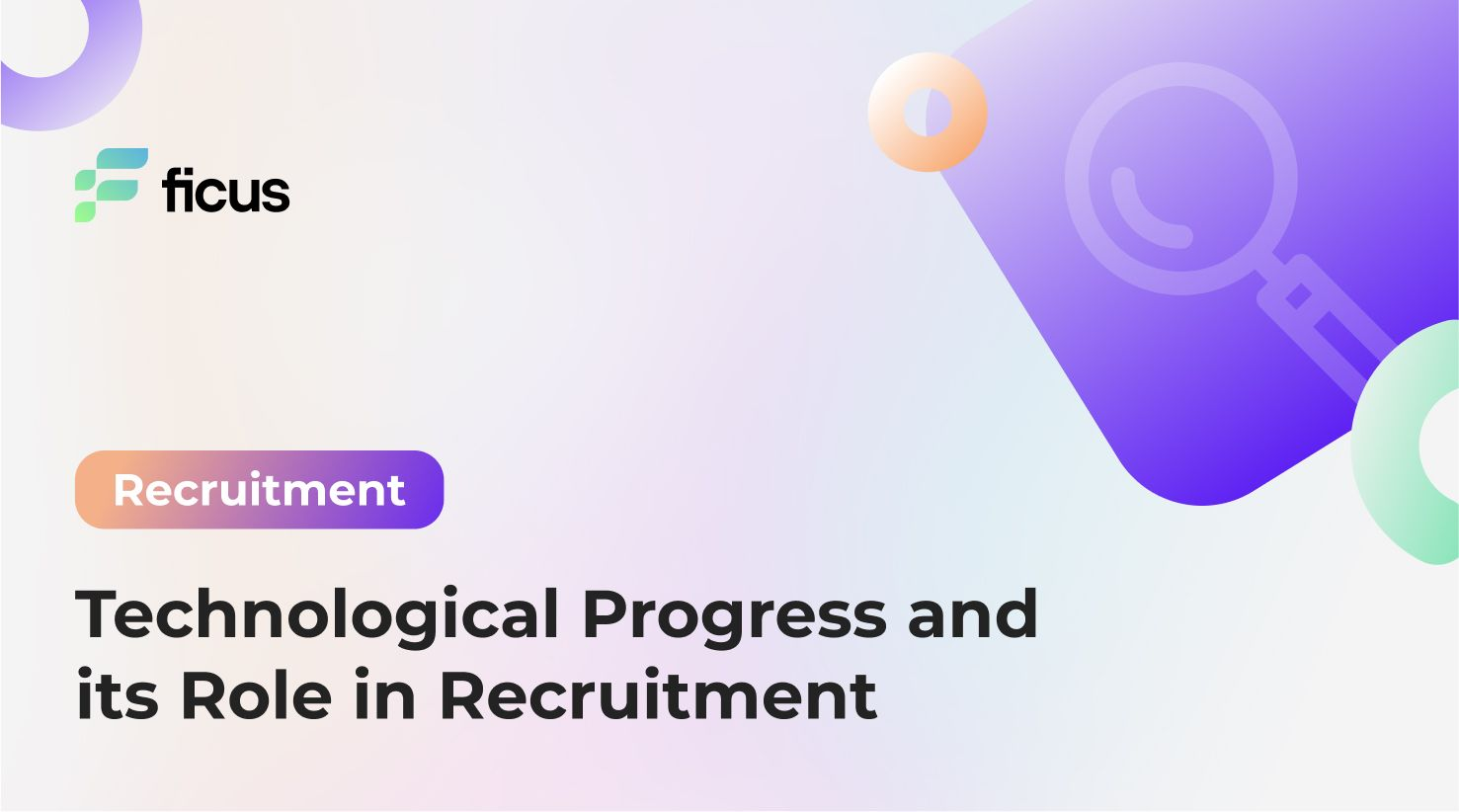In today’s fast-paced and competitive business environment, recruitment technology has emerged as a pivotal force, revolutionizing how companies attract, assess, and hire talent. With the increasing reliance on digital solutions, businesses are no longer confined to traditional methods of recruitment. Instead, they are leveraging advanced tools and platforms that enhance efficiency, reduce time-to-hire, and improve the overall quality of candidates.Recruitment technology integrates a variety of features, from AI-driven screening systems to sophisticated data analytics tools that offer deep insights into candidate potential. These technologies are not just transforming the recruitment landscape—they are setting new standards for how businesses operate and compete in the talent market. Moreover, we will highlight just how Ficus Technologies can aid organizations in enhancing their recruitment processes.
- The Internet and mobile devices have transformed talent acquisition.
- Recruitment technology has evolved, enhancing efficiency and reach.
What Is Recruitment Technology?
Recruitment technology refers to a broad range of digital tools and software systems designed to optimize and enhance the hiring process. These technologies encompass various components, including AI-driven screening systems, applicant tracking systems (ATS), video interview platforms, and data analytics tools.
- AI-Driven Screening Systems: These systems use artificial intelligence to automate the initial stages of candidate screening. By analyzing resumes and matching candidates’ skills to job requirements, they significantly reduce the time and effort required for manual screening.
- Applicant Tracking Systems (ATS): ATS platforms are essential for managing the recruitment process. They allow HR professionals to track candidates through each stage of the hiring process, from application to interview and final selection. This ensures that no candidate is overlooked and that the process is efficient and transparent.
- Video Interview Platforms: Video interview platforms have become increasingly popular, especially in remote hiring scenarios. These platforms enable companies to conduct interviews virtually, saving time and resources while providing a flexible option for candidates.
- Data Analytics Tools: Data analytics in recruitment provides deep insights into candidate behavior, hiring trends, and overall recruitment efficiency. These tools help companies make data-driven decisions, reducing the risk of bad hires and improving the quality of new employees.

The Impact of Recruitment Technology on HR Processes and Business Strategies
Recruitment technology seamlessly integrates with HR processes, aligning with broader business strategies to enhance overall organizational effectiveness. For instance, an applicant tracking system (ATS) can be integrated with other HR systems such as performance management tools, payroll systems, and employee engagement platforms. This integration ensures a smooth transition for new hires from recruitment to onboarding and beyond.
Moreover, recruitment technology supports business strategies by providing actionable insights that inform decision-making. For example, data analytics can reveal patterns in candidate success, helping companies refine their hiring strategies to target individuals who are more likely to succeed in specific roles. This alignment between recruitment and business objectives leads to more effective workforce planning and ultimately contributes to the company’s long-term success.
By utilizing recruitment technology, businesses can not only enhance their hiring processes but also ensure that they are attracting and retaining the right talent to drive growth and innovation.
Treat your employees right, so they won’t use your Internet to search for a new job
Mark Zuckerberg
History of Recruitment Technologies
The evolution of recruitment has been marked by significant technological advancements, transforming how employers connect with potential employees. Believe it or not, the modern recruitment process traces its origins back to World War II. The war created substantial workforce gaps as men were called to join the military efforts, leaving numerous vacancies behind. To address this, staffing agencies emerged, rapidly hiring men and women who were not enlisted. Even after the war ended, professional recruiters continued to assist returning soldiers in finding employment, laying the foundation for the recruitment practices we see today.
Initially, the recruitment process was manual and labor-intensive, relying heavily on paper resumes and face-to-face interviews. Candidates would submit physical copies of their resumes, and recruiters would sift through stacks of paper to identify suitable applicants. This process was time-consuming, prone to human error, and often limited in scope.
The advent of the internet marked a turning point in recruitment. The shift from paper-based methods to digital platforms allowed for a broader reach and more efficient processing of applications. Online job boards emerged, enabling candidates to submit their resumes electronically and apply for positions worldwide. This transition not only streamlined the application process but also opened up new opportunities for both employers and job seekers, making recruitment a more dynamic and accessible field.
The Transition to Tech-Driven Strategies
The transition to tech-driven recruitment strategies has had a profound impact on both efficiency and candidate experience. As technology advanced, recruitment processes evolved to include applicant tracking systems (ATS), AI-driven screening tools, and video interview platforms. These innovations drastically reduced the time required to review applications and improved the accuracy of candidate matching.
For candidates, the integration of technology into recruitment processes has enhanced their experience by providing more personalized and engaging interactions. Online assessments, virtual interviews, and AI-powered chatbots offer a seamless and efficient journey from application to hiring. Candidates can now receive instant feedback, track their application status in real-time, and communicate directly with employers through digital platforms.
The rise of recruitment technology has not only streamlined internal processes for companies but has also improved the candidate experience, making it more transparent, efficient, and tailored to individual needs.
Do you need Recruiting team for your company?
Contact usThe Influence of the Internet on Recruiting
The Internet’s Role in Transforming Recruitment Practices
The internet has played a pivotal role in transforming recruitment practices, fundamentally altering how companies identify, attract, and hire talent. Before the Internet, recruitment was a localized activity, with companies primarily relying on newspaper ads, bulletin boards, and word-of-mouth to find candidates. The internet changed all that by providing a global platform for recruitment, breaking down geographical barriers, and connecting employers with a vast pool of candidates.
With the rise of online job boards and recruitment platforms, companies could post job openings that reached a global audience within seconds. This expanded the talent pool significantly, allowing businesses to access candidates with specialized skills that might have been unavailable locally. Additionally, the internet enabled more sophisticated recruitment tools, such as AI-driven analytics and applicant tracking systems, which allowed for more efficient and data-driven hiring processes.
The Rise of Online Job Boards, Social Media, and Professional Networking Sites
Platforms like LinkedIn, Indeed, and Glassdoor have become essential tools for recruiters, providing access to millions of potential candidates with diverse skill sets. These platforms not only offer a space for job postings but also allow recruiters to proactively search for and engage with top talent.
Social media has also become a powerful tool in recruitment, enabling companies to build their employer brand and attract candidates through targeted content and campaigns. Platforms like Facebook, Twitter, and Instagram allow businesses to reach passive candidates—those who may not be actively seeking a new job but could be enticed by the right opportunity.
Professional networking sites like LinkedIn have added another layer to recruitment by enabling recruiters to connect directly with professionals, participate in industry discussions, and build relationships with potential candidates. This direct engagement allows companies to attract talent more effectively and create a more personalized recruitment experience.
Using Mobile Devices in Recruitment
The Increasing Use of Mobile Devices in Job Searching and Hiring
The increasing use of mobile devices in job searching and hiring is a significant trend in modern recruitment. With smartphones becoming ubiquitous, candidates now can search for jobs, submit applications, and even participate in interviews directly from their mobile devices. This shift towards mobile recruitment reflects the changing preferences of job seekers, who value convenience and flexibility.
Mobile devices have also transformed the way employers engage with candidates. Companies can now reach potential hires through mobile-friendly job ads, SMS notifications, and dedicated recruitment apps. This mobile-centric approach allows for quicker communication, real-time updates, and a more streamlined recruitment process.
The Importance of Mobile-Optimized Recruitment Platforms and Apps
Given the widespread use of mobile devices, companies must have mobile-optimized recruitment platforms and apps. A mobile-friendly recruitment process not only enhances the candidate experience but also increases the likelihood of attracting top talent. Mobile-optimized platforms allow candidates to easily navigate job listings, submit applications, and communicate with recruiters from any location.
Additionally, mobile apps dedicated to recruitment can offer a range of features, such as push notifications for new job openings, in-app messaging, and the ability to schedule interviews on the go. These tools provide a seamless and engaging experience for candidates, ensuring that they remain connected and informed throughout the hiring process.
For employers, investing in mobile-optimized recruitment technologies is essential to staying competitive in the talent market. As more candidates turn to their mobile devices for job searching, companies that provide a smooth, mobile-friendly application process will be better positioned to attract and retain top talent.
The Benefits of Using Recruitment Technology
- Improved Candidate Experience: Recruitment technology significantly enhances the candidate experience by providing a streamlined, efficient, and personalized application process. Features like AI-driven chatbots and automated status updates keep candidates informed and engaged, reducing frustration and improving overall satisfaction. Mobile-optimized platforms also allow candidates to apply for jobs conveniently from their smartphones, further enhancing their experience.
- Faster Hiring Times: By automating repetitive tasks such as resume screening, interview scheduling, and communication, recruitment technology reduces the time it takes to hire a candidate. AI-powered tools can quickly sift through large volumes of applications to identify the most suitable candidates, allowing HR teams to focus on finalizing decisions and onboarding new hires more swiftly.
- Data-Driven Decision-Making: Recruitment technology equips employers with powerful analytics tools that provide deep insights into the recruitment process. Data on candidate behavior, hiring trends, and performance metrics enable HR teams to make informed decisions, optimize their strategies, and reduce the risk of bad hires. This data-driven approach helps ensure that the right candidates are selected based on evidence rather than intuition.
- Enhanced Diversity and Inclusion: Advanced recruitment tools can help promote diversity and inclusion by reducing unconscious bias in the hiring process. AI-driven screening systems can be programmed to focus on candidate qualifications and skills, rather than demographic factors, ensuring that all applicants are considered fairly. Additionally, data analytics can help identify gaps in diversity and guide companies toward more inclusive hiring practices.
- Better Candidate Matching: Recruitment technology improves candidate matching by using sophisticated algorithms to align candidate skills, experience, and preferences with job requirements. This results in higher-quality hires that are better suited to the roles they are selected for, ultimately reducing turnover and increasing job satisfaction.
- Cost Efficiency: Implementing recruitment technology can lead to significant cost savings. Automation reduces the need for manual labor, while data-driven insights help companies allocate their resources more effectively. Additionally, faster hiring processes mean fewer resources spent on prolonged recruitment campaigns, making the entire process more cost-efficient.
- Scalability: Recruitment technology is highly scalable, allowing businesses to handle large volumes of applications without compromising on quality. Whether a company is hiring for a few positions or conducting a mass recruitment drive, technology provides the necessary tools to manage the process efficiently. This scalability is particularly beneficial for growing companies or those with fluctuating hiring needs.
- Improved Compliance and Reporting: Keeping track of compliance with employment laws and regulations can be complex, but recruitment technology simplifies this process. Many recruitment platforms include features that ensure all hiring practices meet legal requirements, and they can generate detailed reports to demonstrate compliance. This reduces the risk of legal issues and helps companies maintain a transparent and fair hiring process.
The Challenges of Using Technology in Recruitment
- Eliminating Bias: While recruitment technology aims to reduce bias, it can also inadvertently perpetuate it if not carefully managed. AI algorithms are only as unbiased as the data they are trained on. If the historical data contains biases, the technology may replicate these biases in the recruitment process. Companies must ensure that their recruitment technology is regularly audited and updated to minimize this risk.
- Data Privacy Concerns: The use of recruitment technology involves collecting and storing large amounts of personal data from candidates. This raises significant privacy concerns, especially with stringent regulations like GDPR in place. Employers must ensure that their recruitment platforms have robust security measures to protect candidate data and comply with privacy laws. Failure to do so can result in legal consequences and damage to the company’s reputation.
- Reliance on Algorithms: Over-reliance on algorithms can lead to challenges in the recruitment process. While AI-driven tools are efficient, they may overlook certain qualities that are difficult to quantify, such as cultural fit or potential for growth. Additionally, algorithms may not fully capture the nuances of human communication, leading to misinterpretations. Balancing technology with human judgment is crucial to ensuring well-rounded hiring decisions.
- The Learning Curve for New Systems: Implementing new recruitment technology often comes with a steep learning curve. HR teams may need to undergo extensive training to effectively use the new tools, which can temporarily slow down the recruitment process. Additionally, there may be resistance to change from employees who are accustomed to traditional methods. Companies must invest in proper training and change management strategies to overcome these challenges.
- Maintaining a Human Touch: One of the biggest challenges of using recruitment technology is maintaining the human touch in the hiring process. While automation and AI can handle many aspects of recruitment, they cannot replace the empathy, understanding, and personal connection that human recruiters provide. Over-automation can lead to a depersonalized candidate experience, where applicants feel like they are interacting with machines rather than people. It’s important to strike a balance between technology and human interaction to create a recruitment process that is both efficient and empathetic.
The Latest Developments in Recruitment Technology
Gamified Assessment Tools
- Gamified assessment tools are revolutionizing the way companies evaluate candidates by making the process more engaging and interactive. Instead of traditional methods like standardized tests or interviews, these tools incorporate game-like elements to assess various skills, such as problem-solving, creativity, and cognitive abilities. Candidates might participate in simulations, challenges, or interactive scenarios that reflect real-world tasks they would encounter on the job. This approach not only provides a more dynamic and enjoyable experience for candidates but also offers employers deeper insights into a candidate’s potential in a more authentic and stress-free environment. As a result, gamified assessments are becoming an increasingly popular tool in the arsenal of recruitment technology, helping companies identify top talent with precision and efficiency.
Candidate Matching Systems
- Candidate matching systems powered by AI are transforming the recruitment landscape by automating the process of finding the perfect match between candidates and job roles. These systems analyze vast amounts of data, including resumes, job descriptions, and even social media profiles, to assess a candidate’s skills, experience, and potential cultural fit with the company. By leveraging machine learning algorithms, these tools can identify patterns and predict which candidates are most likely to succeed in a given role. This not only saves recruiters time by reducing the need for manual resume screening but also improves the accuracy of hiring decisions. As recruitment technology continues to advance, these candidate matching systems are becoming more sophisticated, offering personalized recommendations that align closely with the company’s values and goals.
Video Interviewing Software
- The rise of video interviewing software has been one of the most significant developments in recruitment, especially with the increasing shift toward remote work. This software allows employers to conduct interviews with candidates from anywhere in the world, making the hiring process more flexible and accessible. Video interviews offer several advantages, including the ability to record and review interviews later, share them with other decision-makers, and use AI to analyze verbal and non-verbal cues. This technology also enables companies to standardize the interview process, ensuring that all candidates are assessed fairly and consistently. As remote hiring becomes more common, video interviewing software is becoming an essential tool in the modern recruiter’s toolkit.
Recruitment Marketing Platforms
- Recruitment marketing platforms are playing a crucial role in helping companies attract and engage top talent by promoting their employer brand effectively. These platforms allow businesses to create and distribute targeted content across various channels, such as social media, job boards, and email campaigns, to reach potential candidates. They provide tools for managing employer branding, nurturing candidate relationships, and analyzing the effectiveness of recruitment campaigns. By integrating with other HR systems, these platforms also help track the candidate’s journey from the first point of contact to the final hire. In a competitive job market, recruitment marketing platforms enable companies to stand out by showcasing their unique culture, values, and opportunities, ultimately attracting high-quality candidates who align with their mission.
The Future of Recruitment Technology
Emerging Technologies: Virtual Reality (VR) and Augmented Reality (AR)
- As recruitment technology continues to evolve, emerging technologies like Virtual Reality (VR) and Augmented Reality (AR) are poised to play a transformative role in the hiring process, particularly for remote or virtual recruitment. VR can be used to create immersive experiences where candidates can virtually “walk through” a company’s office, experience the work environment, or participate in simulated tasks that mimic real job scenarios. This gives candidates a more tangible sense of the company culture and the role they’re applying for, which can improve the quality of matches between candidates and jobs.
- AR, on the other hand, can be used to enhance onboarding processes or training sessions, providing new hires with interactive and engaging ways to learn about their roles and responsibilities. For example, AR could overlay instructions or information onto a real-world environment, helping new employees quickly get up to speed with complex tasks. As these technologies become more accessible and affordable, they will likely become standard tools in the recruitment process, offering innovative ways to assess candidates, improve engagement, and enhance the overall hiring experience. The future of recruitment technology promises to be more immersive, interactive, and personalized, paving the way for more effective and efficient hiring practices.
Ficus Technologies in Recruitment
As the recruitment industry continues to evolve with the rapid advancement of technology, Ficus Technologies stands out as a leader in providing innovative solutions that bridge the gap between digital efficiency and human interaction. Ficus Technologies has developed a suite of tools specifically designed to meet the needs of modern recruiters, helping them navigate the complexities of today’s digital landscape while maintaining a personal touch in the hiring process.
What sets Ficus Technologies apart is its commitment to preserving the human element in recruitment. While automation and AI are integral to their tools, Ficus Technologies ensures that these technologies complement, rather than replace, human judgment.
Ready to elevate your recruitment process with Ficus Technologies? Discover how their cutting-edge tools can help you find and hire the best talent while maintaining the human touch that makes your company unique. Reach out to Ficus Technologies today via the Ficus Technologies Contact and take the first step towards revolutionizing your hiring strategy.
Final Thoughts
The landscape of recruitment is undergoing a significant transformation, driven by advancements in technology that promise to make hiring more efficient, data-driven, and personalized. From the evolution of recruitment tools like applicant tracking systems and gamified assessments to the future potential of VR and AR, it’s clear that technology will continue to play a crucial role in shaping the future of hiring. However, as Ficus Technologies demonstrates, the key to successful recruitment lies not only in adopting the latest innovations but also in preserving the human connections that make the hiring process meaningful.
As businesses navigate this new era, those who embrace technology while maintaining a focus on people will be best positioned to attract and retain top talent. The future of recruitment is here, and it’s a future where technology and human interaction go hand in hand.
Employers can ensure ethical and fair use of technology in hiring by implementing unbiased algorithms, regularly auditing their recruitment technology for potential biases, and maintaining transparency in how these tools are used. It’s also crucial to combine automated processes with human oversight to ensure that decisions are made fairly and inclusively.
Mobile recruitment refers to the process of engaging and hiring candidates through mobile devices. This includes mobile-optimized job boards, recruitment apps, and communication channels like SMS or instant messaging. The goal is to make the application process more accessible and convenient for candidates who primarily use mobile devices.
Mobile and social recruiting increase candidate engagement by meeting candidates where they are—on their phones and social media platforms. These methods allow for more immediate, personalized, and interactive communication, making it easier for candidates to learn about job opportunities, engage with employer brands, and apply for positions quickly.
Employers can strike a balance by using technology to handle repetitive tasks and data analysis while reserving human interaction for more nuanced and relationship-building activities. For example, while applicant tracking systems can manage resumes and scheduling, interviews and final hiring decisions should involve direct human engagement to assess cultural fit and personal connections.
Employers can assess the success of their tech-driven recruitment strategies by tracking key performance indicators (KPIs) such as time-to-hire, cost-per-hire, quality of hire, candidate experience ratings, and diversity metrics. Regularly reviewing these metrics helps employers understand the effectiveness of their recruitment technology and make data-driven improvements.








